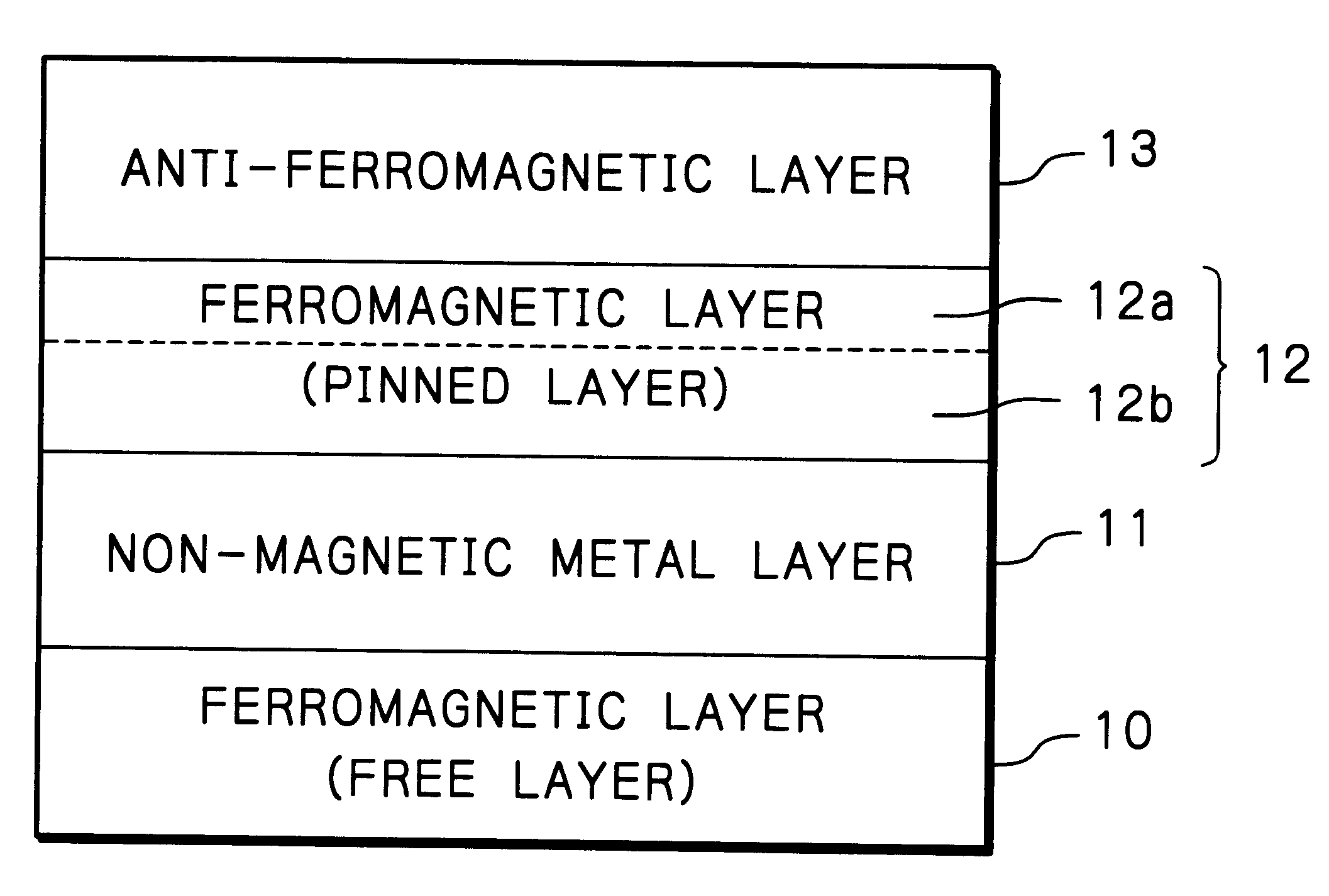Magnetoresistive effect multi-layered structure and thin-film magnetic head with the magnetoresistive effect multi-layered structure
a multi-layered structure and magnetoresistive effect technology, applied in the field of thin-film magnetic head with the magnetoresistive effect multi-layered structure, can solve the problems that no one has approached to control the magnetic characteristics of the pinned ferromagnetic layer itself, and proper anisotropy control cannot be expected
- Summary
- Abstract
- Description
- Claims
- Application Information
AI Technical Summary
Benefits of technology
Problems solved by technology
Method used
Image
Examples
second example
A second example of the multi-layered spin valve effect structure as illustrated in FIG. 1 was actually fabricated by depositing multi-layers under application of magnetic field without heating the substrate. Concretely, the multi-layered structure was formed by sequentially depositing, on the substrate of AlTiC, an under layer of Ta with the thickness of 5.0 nm, a ferromagnetic material layer (free layer) 10 composed of a NiFe layer with the thickness of 9.0 nm and a Co layer with the thickness of 1.0 nm, a non-magnetic metallic material layer 11 of Cu with the thickness of 3.0 nm, a ferromagnetic material layer (pinned layer) 12 having a two layered structure composed of a ferromagnetic material layer 12b of Co.sub.90 Fe.sub.10 (Co is 90 at % and Fe is 10 at %) with the thickness of 1.0 or 2.0 nm and a ferromagnetic material layer 12a of Ni.sub.80 Fe.sub.20 (Ni is 80 at % and Fe is 20 at %) with the thickness of 0-4.0 nm, which has a smaller magnetic anisotropy than that of Co, an...
third example
A third example of the multi-layered spin valve effect structure as illustrated in FIG. 1 was actually fabricated by depositing multi-layers under application of magnetic field without heating the substrate. Concretely, the multi-layered structure was formed by sequentially depositing, on the substrate of AlTiC, an under layer of Ta with the thickness of 5.0 nm, a ferromagnetic material layer (free layer) 10 composed of a NiFe layer with the thickness of 9.0 nm and a Co layer with the thickness of 1.0 nm, a non-magnetic metallic material layer 11 of Cu with the thickness of 3.0 nm, a ferromagnetic material layer (pinned layer) 12 having a two layered structure composed of a ferromagnetic material layer 12b of Co with the thickness of 1.0 or 2.0 nm and a ferromagnetic material layer 12a of Ni.sub.80 Fe.sub.20 (Ni is 80 at % and Fe is 20 at %) with the thickness of 0-4.0 nm, which has a smaller magnetic anisotropy than that of Co, and an anti-ferromagnetic material layer 13 of RuRhMn ...
fourth example
A fourth example of the multi-layered spin valve effect structure as illustrated in FIG. 1 was actually fabricated by depositing multi-layers under application of magnetic field without heating the substrate. Concretely, the multi-layered structure was formed by sequentially depositing, on the substrate of AlTiC, an under layer of Ta with the thickness of 5.0 nm, a ferromagnetic material layer (free layer) 10 composed of a NiFe layer with the thickness of 9.0 nm and a Co layer with the thickness of 1.0 nm, a non-magnetic metallic material layer 11 of Cu with the thickness of 3.0 nm, a ferromagnetic material layer (pinned layer) 12 having a two layered structure composed of a ferromagnetic material layer 12b of Co with the thickness of 1.0 or 2.0 nm and a ferromagnetic material layer 12a of Ni.sub.80 Fe.sub.20 (Ni is 80 at % and Fe is 20 at %) with the thickness of 0-4.0 nm, which has a smaller magnetic anisotropy than that of Co, and an anti-ferromagnetic material layer 13 of FeMn w...
PUM
| Property | Measurement | Unit |
|---|---|---|
| thickness | aaaaa | aaaaa |
| thickness | aaaaa | aaaaa |
| thickness | aaaaa | aaaaa |
Abstract
Description
Claims
Application Information
 Login to View More
Login to View More - R&D
- Intellectual Property
- Life Sciences
- Materials
- Tech Scout
- Unparalleled Data Quality
- Higher Quality Content
- 60% Fewer Hallucinations
Browse by: Latest US Patents, China's latest patents, Technical Efficacy Thesaurus, Application Domain, Technology Topic, Popular Technical Reports.
© 2025 PatSnap. All rights reserved.Legal|Privacy policy|Modern Slavery Act Transparency Statement|Sitemap|About US| Contact US: help@patsnap.com



